Codeforces Round 930 (Div. 2 ABCDEF题) 视频讲解
A. Shuffle Party
Problem Statement
You are given an array a 1 , a 2 , … , a n a_1, a_2, \ldots, a_n a1,a2,…,an. Initially, a i = i a_i=i ai=i for each 1 ≤ i ≤ n 1 \le i \le n 1≤i≤n.
The operation swap ( k ) \texttt{swap}(k) swap(k) for an integer k ≥ 2 k \ge 2 k≥2 is defined as follows:
- Let d d d be the largest divisor † ^\dagger † of k k k which is not equal to k k k itself. Then swap the elements a d a_d ad and a k a_k ak.
Suppose you perform swap ( i ) \texttt{swap}(i) swap(i) for each i = 2 , 3 , … , n i=2,3,\ldots, n i=2,3,…,n in this exact order. Find the position of 1 1 1 in the resulting array. In other words, find such j j j that a j = 1 a_j = 1 aj=1 after performing these operations.
† ^\dagger † An integer x x x is a divisor of y y y if there exists an integer z z z such that y = x ⋅ z y = x \cdot z y=x⋅z.
Input
Each test contains multiple test cases. The first line contains the number of test cases t t t ( 1 ≤ t ≤ 1 0 4 1 \le t \le 10^4 1≤t≤104). The description of the test cases follows.
The only line of each test case contains one integer n n n ( 1 ≤ n ≤ 1 0 9 1 \le n \le 10^9 1≤n≤109) — the length of the array a a a.
Output
For each test case, output the position of 1 1 1 in the resulting array.
Example
Example
| input |
|---|
| 4 |
| 1 |
| 4 |
| 5 |
| 120240229 |
| output |
|---|
| 1 |
| 4 |
| 4 |
| 67108864 |
Note
In the first test case, the array is [ 1 ] [1] [1] and there are no operations performed.
In the second test case, a a a changes as follows:
- Initially, a a a is [ 1 , 2 , 3 , 4 ] [1,2,3,4] [1,2,3,4].
- After performing swap ( 2 ) \texttt{swap}(2) swap(2), a a a changes to [ 2 ‾ , 1 ‾ , 3 , 4 ] [\underline{2},\underline{1},3,4] [2,1,3,4] (the elements being swapped are underlined).
- After performing swap ( 3 ) \texttt{swap}(3) swap(3), a a a changes to [ 3 ‾ , 1 , 2 ‾ , 4 ] [\underline{3},1,\underline{2},4] [3,1,2,4].
- After performing swap ( 4 ) \texttt{swap}(4) swap(4), a a a changes to [ 3 , 4 ‾ , 2 , 1 ‾ ] [3,\underline{4},2,\underline{1}] [3,4,2,1].
Finally, the element 1 1 1 lies on index 4 4 4 (that is, a 4 = 1 a_4 = 1 a4=1). Thus, the answer is 4 4 4.
Solution
具体见文后视频。
Code
#include <bits/stdc++.h>
#define int long longusing namespace std;typedef pair<int, int> PII;
typedef long long LL;void solve()
{int n;cin >> n;int i = 1;while (i * 2 <= n) i *= 2;cout << i << endl;
}signed main()
{cin.tie(0);cout.tie(0);ios::sync_with_stdio(0);int Data;cin >> Data;while (Data --)solve();return 0;
}
B. Binary Path
Problem Statement
You are given a 2 × n 2 \times n 2×n grid filled with zeros and ones. Let the number at the intersection of the i i i-th row and the j j j-th column be a i j a_{ij} aij.
There is a grasshopper at the top-left cell ( 1 , 1 ) (1, 1) (1,1) that can only jump one cell right or downwards. It wants to reach the bottom-right cell ( 2 , n ) (2, n) (2,n). Consider the binary string of length n + 1 n+1 n+1 consisting of numbers written in cells of the path without changing their order.
Your goal is to:
- Find the lexicographically smallest † ^\dagger † string you can attain by choosing any available path;
- Find the number of paths that yield this lexicographically smallest string.
† ^\dagger † If two strings s s s and t t t have the same length, then s s s is lexicographically smaller than t t t if and only if in the first position where s s s and t t t differ, the string s s s has a smaller element than the corresponding element in t t t.
Input
Each test contains multiple test cases. The first line contains the number of test cases t t t ( 1 ≤ t ≤ 1 0 4 1 \le t \le 10^4 1≤t≤104). The description of the test cases follows.
The first line of each test case contains a single integer n n n ( 2 ≤ n ≤ 2 ⋅ 1 0 5 2 \le n \le 2 \cdot 10^5 2≤n≤2⋅105).
The second line of each test case contains a binary string a 11 a 12 … a 1 n a_{11} a_{12} \ldots a_{1n} a11a12…a1n ( a 1 i a_{1i} a1i is either 0 0 0 or 1 1 1).
The third line of each test case contains a binary string a 21 a 22 … a 2 n a_{21} a_{22} \ldots a_{2n} a21a22…a2n ( a 2 i a_{2i} a2i is either 0 0 0 or 1 1 1).
It is guaranteed that the sum of n n n over all test cases does not exceed 2 ⋅ 1 0 5 2 \cdot 10^5 2⋅105.
Output
For each test case, output two lines:
- The lexicographically smallest string you can attain by choosing any available path;
- The number of paths that yield this string.
Example
Example
| input |
|---|
| 3 |
| 2 |
| 00 |
| 00 |
| 4 |
| 1101 |
| 1100 |
| 8 |
| 00100111 |
| 11101101 |
| output |
|---|
| 000 |
| 2 |
| 11000 |
| 1 |
| 001001101 |
| 4 |
Note
In the first test case, the lexicographically smallest string is 000 \mathtt{000} 000. There are two paths that yield this string:
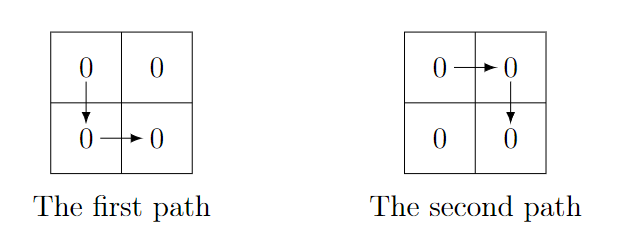
In the second test case, the lexicographically smallest string is 11000 \mathtt{11000} 11000. There is only one path that yields this string:
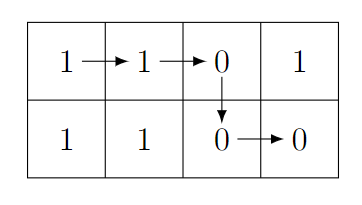
Solution
具体见文后视频。
Code
#include <bits/stdc++.h>
#define int long longusing namespace std;typedef pair<int, int> PII;
typedef long long LL;void solve()
{int n;string s[2];cin >> n >> s[0] >> s[1];int p = n - 1;for (int i = 1; i < n; i ++)if (s[0][i] != '0' && s[1][i - 1] == '0'){p = i - 1;break;}string res;for (int i = 0; i <= p; i ++)res += s[0][i];res += s[1][p];for (int i = p + 1; i < n; i ++)res += s[1][i];int lst = 0;for (int i = n - 1, j = n; i >= 0; i --, j --)if (res[j] != s[1][i]){lst = i + 1;break;}cout << res << endl;cout << p - lst + 1 << endl;
}signed main()
{cin.tie(0);cout.tie(0);ios::sync_with_stdio(0);int Data;cin >> Data;while (Data --)solve();return 0;
}
C. Bitwise Operation Wizard
Problem Statement
There is a secret sequence p 0 , p 1 , … , p n − 1 p_0, p_1, \ldots, p_{n-1} p0,p1,…,pn−1, which is a permutation of { 0 , 1 , … , n − 1 } \{0,1,\ldots,n-1\} {0,1,…,n−1}.
You need to find any two indices i i i and j j j such that p i ⊕ p j p_i \oplus p_j pi⊕pj is maximized, where ⊕ \oplus ⊕ denotes the bitwise XOR operation.
To do this, you can ask queries. Each query has the following form: you pick arbitrary indices a a a, b b b, c c c, and d d d ( 0 ≤ a , b , c , d < n 0 \le a,b,c,d < n 0≤a,b,c,d<n). Next, the jury calculates x = ( p a ∣ p b ) x = (p_a \mid p_b) x=(pa∣pb) and y = ( p c ∣ p d ) y = (p_c \mid p_d) y=(pc∣pd), where ∣ | ∣ denotes the bitwise OR operation. Finally, you receive the result of comparison between x x x and y y y. In other words, you are told if x < y x < y x<y, x > y x > y x>y, or x = y x = y x=y.
Please find any two indices i i i and j j j ( 0 ≤ i , j < n 0 \le i,j < n 0≤i,j<n) such that p i ⊕ p j p_i \oplus p_j pi⊕pj is maximum among all such pairs, using at most 3 n 3n 3n queries. If there are multiple pairs of indices satisfying the condition, you may output any one of them.
Input
Each test contains multiple test cases. The first line contains the number of test cases t t t ( 1 ≤ t ≤ 1 0 3 1 \le t \le 10^3 1≤t≤103). The description of the test cases follows.
Interaction
The first line of each test case contains one integer n n n ( 2 ≤ n ≤ 1 0 4 2 \le n \le 10^4 2≤n≤104). At this moment, the permutation p 0 , p 1 , … , p n − 1 p_0, p_1, \ldots, p_{n-1} p0,p1,…,pn−1 is chosen. The interactor in this task is not adaptive. In other words, the sequence p p p is fixed in every test case and does not change during the interaction.
To ask a query, you need to pick four indices a a a, b b b, c c c, and d d d ( 0 ≤ a , b , c , d < n 0 \le a,b,c,d < n 0≤a,b,c,d<n) and print the line of the following form:
- “? a b c d”
After that, you receive:
- “<” if ( p a ∣ p b ) < ( p c ∣ p d ) (p_a \mid p_b) < (p_c \mid p_d) (pa∣pb)<(pc∣pd);
- “=” if ( p a ∣ p b ) = ( p c ∣ p d ) (p_a \mid p_b) = (p_c \mid p_d) (pa∣pb)=(pc∣pd);
- “>” if ( p a ∣ p b ) > ( p c ∣ p d ) (p_a \mid p_b) > (p_c \mid p_d) (pa∣pb)>(pc∣pd).
You can make at most 3 n 3n 3n queries of this form.
Next, if your program has found a pair of indices i i i and j j j ( 0 ≤ i , j < n 0 \le i, j < n 0≤i,j<n) such that p i ⊕ p j p_i \oplus p_j pi⊕pj is maximized, print the line of the following form:
- “! i j”
Note that this line is not considered a query and is not taken into account when counting the number of queries asked.
After this, proceed to the next test case.
If you make more than 3 n 3n 3n queries during an interaction, your program must terminate immediately, and you will receive the Wrong Answer verdict. Otherwise, you can get an arbitrary verdict because your solution will continue to read from a closed stream.
After printing a query or the answer for a test case, do not forget to output the end of line and flush the output. Otherwise, you will get the verdict Idleness Limit Exceeded. To do this, use:
- fflush(stdout) or cout.flush() in C++;
- System.out.flush() in Java;
- flush(output) in Pascal;
- stdout.flush() in Python;
- see the documentation for other languages.
It is guaranteed that the sum of n n n over all test cases does not exceed 1 0 4 10^4 104.
Hacks
To hack, follow the test format below.
The first line contains the number of test cases t t t ( 1 ≤ t ≤ 1 0 3 1 \le t \le 10^3 1≤t≤103). The description of the test cases follows.
The first line of each test case contains one integer n n n ( 2 ≤ n ≤ 1 0 4 2 \le n \le 10^4 2≤n≤104).
The second line of each test case contains n n n integers p 0 , p 1 , … , p n − 1 p_0,p_1,\ldots,p_{n-1} p0,p1,…,pn−1, which represent a permutation of integers from 0 0 0 to n − 1 n - 1 n−1.
The sum of n n n over all test cases should not exceed 1 0 4 10^4 104.
Example
| input |
|---|
| 2 |
| 4 |
| < |
| = |
| > |
2
| output |
|---|
| ? 0 2 3 1 |
| ? 1 1 2 3 |
| ? 1 2 0 3 |
| ! 3 2 |
| ! 0 1 |
Note
In the first test case, the hidden permutation is p = [ 0 , 3 , 1 , 2 ] p=[0,3,1,2] p=[0,3,1,2].
For the query “? 0 2 3 1”, the jury return “<” because ( p 0 ∣ p 2 ) = ( 0 ∣ 1 ) = 1 < ( p 3 ∣ p 1 ) = ( 2 ∣ 3 ) = 3 (p_0 \mid p_2) = (0 \mid 1) =1 < (p_3 \mid p_1) = (2 \mid 3) = 3 (p0∣p2)=(0∣1)=1<(p3∣p1)=(2∣3)=3.
For the query “? 1 1 2 3”, the jury return “=” because ( p 1 ∣ p 1 ) = ( 3 ∣ 3 ) = 3 = ( p 2 ∣ p 3 ) = ( 1 ∣ 2 ) = 3 (p_1 \mid p_1) = (3\mid 3)= 3 = (p_2 \mid p_3) = (1 \mid 2)=3 (p1∣p1)=(3∣3)=3=(p2∣p3)=(1∣2)=3.
For the query “? 1 2 0 3”, the jury return “>” because ( p 1 ∣ p 2 ) = ( 3 ∣ 1 ) = 3 > ( p 0 ∣ p 3 ) = ( 0 ∣ 2 ) = 2 (p_1 \mid p_2) = (3 \mid 1) = 3 > (p_0 \mid p_3) = (0\mid 2)=2 (p1∣p2)=(3∣1)=3>(p0∣p3)=(0∣2)=2.
The answer i = 3 i = 3 i=3 and j = 2 j = 2 j=2 is valid: ( p 3 ⊕ p 2 ) = ( 2 ⊕ 1 ) = 3 (p_3 \oplus p_2) = (2 \oplus 1) = 3 (p3⊕p2)=(2⊕1)=3 is indeed equal to the maximum possible value of p i ⊕ p j p_i \oplus p_j pi⊕pj. Another valid answer would be i = 0 i=0 i=0 and j = 1 j=1 j=1. As the number of queries does not exceed 3 n = 12 3n=12 3n=12, the answer is considered correct.
In the second test case, n = 2 n = 2 n=2, so p p p is either [ 0 , 1 ] [0, 1] [0,1] or [ 1 , 0 ] [1, 0] [1,0]. In any case, p 0 ⊕ p 1 = 1 p_0 \oplus p_1 = 1 p0⊕p1=1 is maximum possible.
Solution
具体见文后视频。
Code
#include <bits/stdc++.h>
#define int long longusing namespace std;typedef pair<int, int> PII;
typedef long long LL;int ask(int a, int b, int c, int d)
{cout << "? " << a << " " << b << " " << c << " " << d << endl;char t;cin >> t;if (t == '=') return 0;else if (t == '<') return 1;else return 2;
}void solve()
{int n;cin >> n;int mx = 0;for (int i = 1; i < n; i ++)if (ask(mx, mx, i, i) == 1)mx = i;std::vector<int> best;best.push_back(0);for (int i = 1; i < n; i ++){int j = *best.begin(), v = ask(i, mx, j, mx);if (v == 2)best.clear(), best.push_back(i);else if (v == 0)best.push_back(i);}int mn = *best.begin();for (int i = 1; i < best.size(); i ++)if (ask(mn, mn, best[i], best[i]) == 2)mn = best[i];cout << "! " << mx << " " << mn << endl;
}signed main()
{cin.tie(0);cout.tie(0);ios::sync_with_stdio(0);int Data;cin >> Data;while (Data --)solve();return 0;
}
D. Pinball
Problem Statement
There is a one-dimensional grid of length n n n. The i i i-th cell of the grid contains a character s i s_i si, which is either ‘<’ or ‘>’.
When a pinball is placed on one of the cells, it moves according to the following rules:
- If the pinball is on the i i i-th cell and s i s_i si is ‘<’, the pinball moves one cell to the left in the next second. If s i s_i si is ‘>’, it moves one cell to the right.
- After the pinball has moved, the character s i s_i si is inverted (i. e. if s i s_i si used to be ‘<’, it becomes ‘>’, and vice versa).
- The pinball stops moving when it leaves the grid: either from the left border or from the right one.
You need to answer n n n independent queries. In the i i i-th query, a pinball will be placed on the i i i-th cell. Note that we always place a pinball on the initial grid.
For each query, calculate how many seconds it takes the pinball to leave the grid. It can be shown that the pinball will always leave the grid within a finite number of steps.
Input
Each test contains multiple test cases. The first line contains the number of test cases t t t ( 1 ≤ t ≤ 1 0 5 1 \le t \le 10^5 1≤t≤105). The description of the test cases follows.
The first line of each test case contains an integer n n n ( 1 ≤ n ≤ 5 ⋅ 1 0 5 1 \le n \le 5 \cdot 10^5 1≤n≤5⋅105).
The second line of each test case contains a string s 1 s 2 … s n s_1s_2 \ldots s_{n} s1s2…sn of length n n n consisting of characters ‘<’ and ‘>’.
It is guaranteed that the sum of n n n over all test cases does not exceed 5 ⋅ 1 0 5 5 \cdot 10^5 5⋅105.
Output
For each test case, for each i i i ( 1 ≤ i ≤ n 1 \le i \le n 1≤i≤n) output the answer if a pinball is initially placed on the i i i-th cell.
Example
Example
| input |
|---|
| 3 |
| 3 |
| ><< |
| 4 |
| <<<< |
| 6 |
| <><<<> |
| output |
|---|
| 3 6 5 |
| 1 2 3 4 |
| 1 4 7 10 8 1 |
Note
In the first test case, the movement of the pinball for i = 1 i=1 i=1 is shown in the following pictures. It takes the pinball 3 3 3 seconds to leave the grid.

The movement of the pinball for i = 2 i=2 i=2 is shown in the following pictures. It takes the pinball 6 6 6 seconds to leave the grid.

Solution
具体见文后视频。
Code
#include <bits/stdc++.h>
#define int long longusing namespace std;typedef pair<int, int> PII;
typedef long long LL;void solve()
{int n;string s;cin >> n >> s;s = '>' + s + '<';int lst = 0;std::vector<int> pre(n + 2, 0), suf(n + 2, 0), less(n + 2, 0), grt(n + 2, 0);std::vector<int> cnt1(n + 2, 0), cnt2(n + 2, 0), pos1, pos2;for (int i = 1; i <= n; i ++){cnt1[i] = cnt1[i - 1] + (s[i] == '>');pre[i] = pre[i - 1] + (s[i] == '>') * i;if (s[i] == '<' && lst) less[i] = less[i - 1] + i - lst, lst = i;else if (s[i] == '<') less[i] = less[i - 1], lst = i;else less[i] = less[i - 1];}lst = 0;for (int i = n; i >= 1; i --){suf[i] = suf[i + 1] + (s[i] == '<') * i, cnt2[i] = cnt2[i + 1] + (s[i] == '<');if (s[i] == '<') pos1.push_back(i);else pos2.push_back(i);if (s[i] == '>' && lst) grt[i] = grt[i + 1] + lst - i, lst = i;else if (s[i] == '>') grt[i] = grt[i + 1], lst = i;else grt[i] = grt[i + 1];}pos1.push_back(n + 1), pos2.push_back(0);sort(pos1.begin(), pos1.end());sort(pos2.begin(), pos2.end());for (int i = 1; i <= n; i ++){// cerr << i << ":";if (cnt1[i] > cnt2[i] || (cnt1[i] == cnt2[i] && s[i] == '<')){int tot = min(cnt1[i], cnt2[i]);if (!cnt2[i]){cout << n - i + 1 << " ";continue;}if (s[i] == '<'){auto it = lower_bound(pos1.begin(), pos1.end(), i), it2 = lower_bound(pos2.begin(), pos2.end(), i);int l1 = it - pos1.begin();int r1 = l1 + tot - 1;int r2 = ( -- it2) - pos2.begin();int l2 = r2 - tot + 1;cout << ((suf[pos1[l1]] - suf[pos1[r1] + 1]) - (pre[pos2[r2]] - pre[pos2[l2] - 1])) * 2 + less[pos1[r1]] - less[pos1[l1]] + (n - pos1[r1] + 1) << " ";}else{auto it = lower_bound(pos2.begin(), pos2.end(), i), it2 = lower_bound(pos1.begin(), pos1.end(), i);auto r1 = it - pos2.begin();int l1 = r1 - tot + 1;auto l2 = it2 - pos1.begin();int r2 = l2 + tot - 1;int v = ((suf[pos1[l2]] - suf[pos1[r2] + 1]) - (pre[pos2[r1]] - pre[pos2[l1] - 1])) * 2 + grt[pos2[l1 - 1]] - grt[pos2[r1]];cout << v + n - pos2[l1 - 1] + 1 << " ";}}else{int tot = min(cnt1[i], cnt2[i]);if (!cnt1[i]){cout << i << " ";continue;}if (s[i] == '<'){auto it = lower_bound(pos1.begin(), pos1.end(), i), it2 = lower_bound(pos2.begin(), pos2.end(), i);auto l1 = it - pos1.begin();int r1 = l1 + tot - 1;auto r2 = ( -- it2) - pos2.begin();int l2 = r2 - tot + 1;int v = ((suf[pos1[l1]] - suf[pos1[r1] + 1]) - (pre[pos2[r2]] - pre[pos2[l2] - 1])) * 2 + less[pos1[r1 + 1]] - less[pos1[l1]];cout << v + pos1[r1 + 1] << " ";}else{auto it = lower_bound(pos2.begin(), pos2.end(), i), it2 = lower_bound(pos1.begin(), pos1.end(), i);auto r1 = it - pos2.begin();int l1 = r1 - tot + 1;auto l2 = it2 - pos1.begin();int r2 = l2 + tot - 1;// cerr << l2 << " " << r2 << " " << l1 << " " << r1 << endl;int v = ((suf[pos1[l2]] - suf[pos1[r2] + 1]) - (pre[pos2[r1]] - pre[pos2[l1] - 1])) * 2 + grt[pos2[l1]] - grt[pos2[r1]];cout << v + pos2[l1] << " ";}}}cout << endl;
}signed main()
{cin.tie(0);cout.tie(0);ios::sync_with_stdio(0);int Data;cin >> Data;while (Data --)solve();return 0;
}
E. Pokémon Arena
Problem Statement
You are at a dueling arena. You also possess n n n Pokémons. Initially, only the 1 1 1-st Pokémon is standing in the arena.
Each Pokémon has m m m attributes. The j j j-th attribute of the i i i-th Pokémon is a i , j a_{i,j} ai,j. Each Pokémon also has a cost to be hired: the i i i-th Pokémon’s cost is c i c_i ci.
You want to have the n n n-th Pokémon stand in the arena. To do that, you can perform the following two types of operations any number of times in any order:
- Choose three integers i i i, j j j, k k k ( 1 ≤ i ≤ n 1 \le i \le n 1≤i≤n, 1 ≤ j ≤ m 1 \le j \le m 1≤j≤m, k > 0 k > 0 k>0), increase a i , j a_{i,j} ai,j by k k k permanently. The cost of this operation is k k k.
- Choose two integers i i i, j j j ( 1 ≤ i ≤ n 1 \le i \le n 1≤i≤n, 1 ≤ j ≤ m 1 \le j \le m 1≤j≤m) and hire the i i i-th Pokémon to duel with the current Pokémon in the arena based on the j j j-th attribute. The i i i-th Pokémon will win if a i , j a_{i,j} ai,j is greater than or equal to the j j j-th attribute of the current Pokémon in the arena (otherwise, it will lose). After the duel, only the winner will stand in the arena. The cost of this operation is c i c_i ci.
Find the minimum cost you need to pay to have the n n n-th Pokémon stand in the arena.
Input
Each test contains multiple test cases. The first line contains the number of test cases t t t ( 1 ≤ t ≤ 1 0 5 1 \le t \le 10^5 1≤t≤105). The description of the test cases follows.
The first line of each test case contains two integers n n n and m m m ( 2 ≤ n ≤ 4 ⋅ 1 0 5 2 \le n \le 4 \cdot 10^5 2≤n≤4⋅105, 1 ≤ m ≤ 2 ⋅ 1 0 5 1 \le m \le 2 \cdot 10^5 1≤m≤2⋅105, 2 ≤ n ⋅ m ≤ 4 ⋅ 1 0 5 2 \leq n \cdot m \leq 4 \cdot 10^5 2≤n⋅m≤4⋅105).
The second line of each test case contains n n n integers c 1 , c 2 , … , c n c_1, c_2, \ldots, c_n c1,c2,…,cn ( 1 ≤ c i ≤ 1 0 9 1 \le c_i \le 10^9 1≤ci≤109).
The i i i-th of the following n n n lines contains m m m integers a i , 1 , a i , 2 , … , a i , m a_{i,1}, a_{i,2}, \ldots, a_{i,m} ai,1,ai,2,…,ai,m ( 1 ≤ a i , j ≤ 1 0 9 1 \le a_{i,j} \le 10^9 1≤ai,j≤109).
It is guaranteed that the sum of n ⋅ m n \cdot m n⋅m over all test cases does not exceed 4 ⋅ 1 0 5 4 \cdot 10^5 4⋅105.
Output
For each test case, output the minimum cost to make the n n n-th Pokémon stand in the arena.
Example
| input |
|---|
| 4 |
| 3 3 |
| 2 3 1 |
| 2 9 9 |
| 6 1 7 |
| 1 2 1 |
| 3 3 |
| 2 3 1 |
| 9 9 9 |
| 6 1 7 |
| 1 2 1 |
| 4 2 |
| 2 8 3 5 |
| 18 24 |
| 17 10 |
| 1 10 |
| 1 1 |
| 6 3 |
| 21412674 3212925 172015806 250849370 306960171 333018900 |
| 950000001 950000001 950000001 |
| 821757276 783362401 760000001 |
| 570000001 700246226 600757652 |
| 380000001 423513575 474035234 |
| 315201473 300580025 287023445 |
| 1 1 1 |
| output |
|---|
| 2 |
| 6 |
| 17 |
| 1224474550 |
Note
In the first test case, the attribute array of the 1 1 1-st Pokémon (which is standing in the arena initially) is [ 2 , 9 , 9 ] [2,9,9] [2,9,9].
In the first operation, you can choose i = 3 i=3 i=3, j = 1 j=1 j=1, k = 1 k=1 k=1, and increase a 3 , 1 a_{3,1} a3,1 by 1 1 1 permanently. Now the attribute array of the 3 3 3-rd Pokémon is [ 2 , 2 , 1 ] [2,2,1] [2,2,1]. The cost of this operation is k = 1 k = 1 k=1.
In the second operation, you can choose i = 3 i=3 i=3, j = 1 j=1 j=1, and hire the 3 3 3-rd Pokémon to duel with the current Pokémon in the arena based on the 1 1 1-st attribute. Since a i , j = a 3 , 1 = 2 ≥ 2 = a 1 , 1 a_{i,j}=a_{3,1}=2 \ge 2=a_{1,1} ai,j=a3,1=2≥2=a1,1, the 3 3 3-rd Pokémon will win. The cost of this operation is c 3 = 1 c_3 = 1 c3=1.
Thus, we have made the 3 3 3-rd Pokémon stand in the arena within the cost of 2 2 2. It can be proven that 2 2 2 is minimum possible.
In the second test case, the attribute array of the 1 1 1-st Pokémon in the arena is [ 9 , 9 , 9 ] [9,9,9] [9,9,9].
In the first operation, you can choose i = 2 i=2 i=2, j = 3 j=3 j=3, k = 2 k=2 k=2, and increase a 2 , 3 a_{2,3} a2,3 by 2 2 2 permanently. Now the attribute array of the 2 2 2-nd Pokémon is [ 6 , 1 , 9 ] [6,1,9] [6,1,9]. The cost of this operation is k = 2 k = 2 k=2.
In the second operation, you can choose i = 2 i=2 i=2, j = 3 j=3 j=3, and hire the 2 2 2-nd Pokémon to duel with the current Pokémon in the arena based on the 3 3 3-rd attribute. Since a i , j = a 2 , 3 = 9 ≥ 9 = a 1 , 3 a_{i,j}=a_{2,3}=9 \ge 9=a_{1,3} ai,j=a2,3=9≥9=a1,3, the 2 2 2-nd Pokémon will win. The cost of this operation is c 2 = 3 c_2 = 3 c2=3.
In the third operation, you can choose i = 3 i=3 i=3, j = 2 j=2 j=2, and hire the 3 3 3-rd Pokémon to duel with the current Pokémon in the arena based on the 2 2 2-nd attribute. Since a i , j = a 1 , 2 = 2 ≥ 1 = a 2 , 2 a_{i,j}=a_{1,2}=2 \ge 1=a_{2,2} ai,j=a1,2=2≥1=a2,2, the 3 3 3-rd Pokémon can win. The cost of this operation is c 3 = 1 c_3 = 1 c3=1.
Thus, we have made the 3 3 3-rd Pokémon stand in the arena within the cost of 6 6 6. It can be proven that 6 6 6 is minimum possible.
Solution
具体见文后视频。
Code
#include <bits/stdc++.h>
#define int long longusing namespace std;typedef pair<int, int> PII;
typedef long long LL;const int N = 4e6 + 10;int h[N], e[N], ne[N], w[N], idx, id, dist[N], Vis[N];void add(int a, int b, int c)
{e[idx] = b, ne[idx] = h[a], w[idx] = c, h[a] = idx ++;
}void solve()
{int n, m;cin >> n >> m;for (int i = 1; i <= 3 * n * m; i ++)h[i] = -1;idx = 0;std::vector<int> c(n + 1);std::vector<vector<int>> a(n + 1, vector<int>(m + 1));for (int i = 1; i <= n; i ++)cin >> c[i];for (int i = 1; i <= n; i ++)for (int j = 1; j <= m; j ++)cin >> a[i][j];id = n;for (int j = 1; j <= m; j ++){std::vector<PII> v;for (int i = 1; i <= n; i ++)v.emplace_back(a[i][j], i);sort(v.begin(), v.end(), greater<>());int source = id + 1;for (auto i : v)add(i.second, ++ id, c[i.second]), add( ++ id, i.second, 0);//, cout << id << " " << i.second << " " << 0 << endl;for (int i = source; i <= id; i += 2)add(i, i + 1, 0);//, cerr << i << " " << i + 1 << " " << 0 << endl;for (int i = source, k = 1; i + 2 <= id; i += 2, k ++)add(i + 2, i, v[k - 1].first - v[k].first);//, cerr << i + 2 << " " << i << " " << v[k - 1].first - v[k].first << endl;for (int i = source + 1; i + 2 <= id; i += 2)add(i, i + 2, 0);//, cerr << i << " " << i + 2 << " " << 0 << endl;}for (int i = 1; i <= id; i ++) dist[i] = 1e18, Vis[i] = 0;priority_queue<PII, vector<PII>, greater<PII>> Heap;Heap.emplace(0, n), dist[n] = 0;while (Heap.size()){auto Tmp = Heap.top();Heap.pop();int u = Tmp.second;if (Vis[u]) continue;Vis[u] = 1;for (int i = h[u]; ~i; i = ne[i]){int j = e[i];if (dist[j] > dist[u] + w[i]){dist[j] = dist[u] + w[i];Heap.emplace(dist[j], j);}}}cout << dist[1] << endl;
}signed main()
{cin.tie(0);cout.tie(0);ios::sync_with_stdio(0);int Data;cin >> Data;while (Data --)solve();return 0;
}
F. Bitwise Paradox
Problem Statement
You are given two arrays a a a and b b b of size n n n along with a fixed integer v v v.
An interval [ l , r ] [l, r] [l,r] is called a good interval if ( b l ∣ b l + 1 ∣ … ∣ b r ) ≥ v (b_l \mid b_{l+1} \mid \ldots \mid b_r) \ge v (bl∣bl+1∣…∣br)≥v, where ∣ | ∣ denotes the bitwise OR operation. The beauty of a good interval is defined as max ( a l , a l + 1 , … , a r ) \max(a_l, a_{l+1}, \ldots, a_r) max(al,al+1,…,ar).
You are given q q q queries of two types:
- “1 i x”: assign b i : = x b_i := x bi:=x;
- “2 l r”: find the minimum beauty among all good intervals [ l 0 , r 0 ] [l_0,r_0] [l0,r0] satisfying l ≤ l 0 ≤ r 0 ≤ r l \le l_0 \le r_0 \le r l≤l0≤r0≤r. If there is no suitable good interval, output − 1 -1 −1 instead.
Please process all queries.
Input
Each test contains multiple test cases. The first line contains the number of test cases t t t ( 1 ≤ t ≤ 1 0 5 1 \le t \le 10^5 1≤t≤105). The description of the test cases follows.
The first line of each test case contains two integers n n n and v v v ( 1 ≤ n ≤ 2 ⋅ 1 0 5 1 \le n \le 2 \cdot 10^5 1≤n≤2⋅105, 1 ≤ v ≤ 1 0 9 1 \le v \le 10^9 1≤v≤109).
The second line of each testcase contains n n n integers a 1 , a 2 , … , a n a_1, a_2, \ldots, a_n a1,a2,…,an ( 1 ≤ a i ≤ 1 0 9 1 \le a_i \le 10^9 1≤ai≤109).
The third line of each testcase contains n n n integers b 1 , b 2 , … , b n b_1, b_2, \ldots, b_n b1,b2,…,bn ( 1 ≤ b i ≤ 1 0 9 1 \le b_i \le 10^9 1≤bi≤109).
The fourth line of each testcase contains one integer q q q ( 1 ≤ q ≤ 2 ⋅ 1 0 5 1 \le q \le 2 \cdot 10^5 1≤q≤2⋅105).
The i i i-th of the following q q q lines contains the description of queries. Each line is of one of two types:
- “1 i x” ( 1 ≤ i ≤ n 1 \le i \le n 1≤i≤n, 1 ≤ x ≤ 1 0 9 ) 1 \le x \le 10^9) 1≤x≤109);
- “2 l r” ( 1 ≤ l ≤ r ≤ n 1 \le l \le r \le n 1≤l≤r≤n).
It is guaranteed that both the sum of n n n and the sum of q q q over all test cases do not exceed 2 ⋅ 1 0 5 2 \cdot 10^5 2⋅105.
Output
For each test case, output the answers for all queries of the second type.
Example
| input |
|---|
| 3 |
| 3 7 |
| 2 1 3 |
| 2 2 3 |
| 4 |
| 2 1 3 |
| 1 2 5 |
| 2 2 3 |
| 2 1 3 |
| 4 5 |
| 5 1 2 4 |
| 4 2 3 3 |
| 6 |
| 2 1 4 |
| 1 3 15 |
| 2 3 4 |
| 2 2 4 |
| 1 2 13 |
| 2 1 4 |
| 1 5 |
| 6 |
| 4 |
| 1 |
| 2 1 1 |
| output |
|---|
| -1 3 2 |
| 5 2 2 1 |
| -1 |
Note
In the first test case, a = [ 2 , 1 , 3 ] a = [2, 1, 3] a=[2,1,3], b = [ 2 , 2 , 3 ] b = [2, 2, 3] b=[2,2,3], and v = 7 v = 7 v=7.
The first query is of the second type and has l = 1 l = 1 l=1 and r = 3 r = 3 r=3. The largest interval available is [ 1 , 3 ] [1, 3] [1,3], and its bitwise OR is b 1 ∣ b 2 ∣ b 3 = 3 b_1 \mid b_2 \mid b_3 = 3 b1∣b2∣b3=3 which is less than v v v. Thus, no good interval exists.
The second query asks to change b 2 b_2 b2 to 5 5 5, so b b b becomes [ 2 , 5 , 3 ] [2, 5, 3] [2,5,3].
The third query is of the second type and has l = 2 l = 2 l=2 and r = 3 r = 3 r=3. There are three possible intervals: [ 2 , 2 ] [2, 2] [2,2], [ 3 , 3 ] [3, 3] [3,3], and [ 2 , 3 ] [2, 3] [2,3]. However, b 2 = 5 < v b_2 = 5 < v b2=5<v, b 3 = 3 < v b_3 = 3 < v b3=3<v. So only the last interval is good: it has b 2 ∣ b 3 = 7 b_2 \mid b_3 = 7 b2∣b3=7. The answer is thus max ( a 2 , a 3 ) = 3 \max(a_2, a_3) = 3 max(a2,a3)=3.
The fourth query is of the second type and has l = 1 l = 1 l=1 and r = 3 r = 3 r=3. There are three good intervals: [ 1 , 2 ] [1, 2] [1,2], [ 2 , 3 ] [2, 3] [2,3], and [ 1 , 3 ] [1, 3] [1,3]. Their beauty is 2 2 2, 3 3 3, 3 3 3 correspondingly. The answer is thus 2 2 2.
In the second test case, a = [ 5 , 1 , 2 , 4 ] a = [5, 1, 2, 4] a=[5,1,2,4], b = [ 4 , 2 , 3 , 3 ] b = [4, 2, 3, 3] b=[4,2,3,3], and v = 5 v = 5 v=5.
The first query has l = 1 l = 1 l=1 and r = 4 r = 4 r=4. The only good intervals are: [ 1 , 2 ] [1, 2] [1,2], [ 1 , 3 ] [1, 3] [1,3], [ 1 , 4 ] [1, 4] [1,4]. Their beauty is 5 5 5, 5 5 5, 5 5 5 correspondingly. The answer is thus 5 5 5.
Solution
具体见文后视频。
Code
#include <bits/stdc++.h>using namespace std;typedef pair<int, int> PII;
typedef long long LL;const int N = 2e5 + 10, INF = 2e9;int n, q, v;
int a[N], b[N];
int F1[N][32], lg[N];
struct Segment
{int l, r;int pre[32], suf[32], res;
}Tree[N << 2];void Init()
{int m = log2(n) + 1;for (int j = 0; j < m; j ++ )for (int i = 1; i + (1 << j) - 1 <= n; i ++ )if (!j) F1[i][j] = a[i];else F1[i][j] = max(F1[i][j - 1], F1[i + (1 << j - 1)][j - 1]);
}inline int Max(int l, int r)
{int len = r - l + 1;int k = lg[len];return max(F1[l][k], F1[r - (1 << k) + 1][k]);
}void Pushup(Segment &rt, Segment L, Segment R)
{rt.l = L.l, rt.r = R.r;for (int i = 30; i >= 0; i --)rt.pre[i] = L.pre[i] ? L.pre[i] : R.pre[i], rt.suf[i] = R.suf[i] ? R.suf[i] : L.suf[i];int pl = L.r, pr = R.l;rt.res = min(L.res, R.res);for (int i = 30; i >= 0; i --){int p = L.suf[i], q = R.pre[i];if (p) p = min(p, pl);if (q) q = max(q, pr);int lr = p ? Max(p, pr) : INF, rr = q ? Max(pl, q) : INF;if (lr < rr){if (v >> i & 1){if (lr < rt.res)pl = p;else break;}elsert.res = min(rt.res, lr);}else{if (v >> i & 1){if (rr < rt.res)pr = q;else break;}elsert.res = min(rt.res, rr);}}
}void Build(int u, int l, int r)
{Tree[u] = {l, r};if (l == r){if (b[l] > v) Tree[u].res = a[l];else Tree[u].res = INF;for (int i = 30; i >= 0; i --)if (b[l] >> i & 1)Tree[u].pre[i] = Tree[u].suf[i] = l;return;}int mid = l + r >> 1;Build(u << 1, l, mid), Build(u << 1 | 1, mid + 1, r);Pushup(Tree[u], Tree[u << 1], Tree[u << 1 | 1]);
}void Modify(int u, int x, int d)
{if (Tree[u].l == Tree[u].r){if (d > v) Tree[u].res = a[x];else Tree[u].res = INF;for (int i = 30; i >= 0; i --)if (d >> i & 1)Tree[u].pre[i] = Tree[u].suf[i] = x;elseTree[u].pre[i] = Tree[u].suf[i] = 0;return;}int mid = Tree[u].l + Tree[u].r >> 1;if (mid >= x) Modify(u << 1, x, d);else Modify(u << 1 | 1, x, d);Pushup(Tree[u], Tree[u << 1], Tree[u << 1 | 1]);
}Segment Query(int u, int l, int r)
{if (Tree[u].l >= l && Tree[u].r <= r)return Tree[u];int mid = Tree[u].l + Tree[u].r >> 1;if (mid >= l && mid < r){Segment res;Pushup(res, Query(u << 1, l, r), Query(u << 1 | 1, l, r));return res;}else if (mid >= l) return Query(u << 1, l, r);else return Query(u << 1 | 1, l, r);
}void solve()
{cin >> n >> v;v --;for (int i = 1, j = 1, k = 0; i <= n; i ++){if (j * 2 <= i) k ++, j *= 2;lg[i] = k;}for (int i = 1; i <= n; i ++)cin >> a[i];for (int i = 1; i <= n; i ++)cin >> b[i];Init(), Build(1, 1, n);cin >> q;while (q --){int op, l, r;cin >> op >> l >> r;if (op == 1)Modify(1, l, r);else{int v = Query(1, l, r).res;if (v == INF) printf("-1 ");else printf("%d ", v);}}printf("\n");
}signed main()
{cin.tie(0);cout.tie(0);ios::sync_with_stdio(0);int Data;cin >> Data;while (Data --)solve();return 0;
}
视频讲解
Codeforces Round 930 (Div. 2)(A ~ F 题讲解)
最后祝大家早日
相关文章:

Codeforces Round 930 (Div. 2 ABCDEF题) 视频讲解
A. Shuffle Party Problem Statement You are given an array a 1 , a 2 , … , a n a_1, a_2, \ldots, a_n a1,a2,…,an. Initially, a i i a_ii aii for each 1 ≤ i ≤ n 1 \le i \le n 1≤i≤n. The operation swap ( k ) \texttt{swap}(k) swap(k) for an…...

【LeetCode-中等】209.长度最小的子数组-双指针/滑动窗口
力扣题目链接 1. 暴力解法 这道题的暴力解法是两层嵌套for循环,第一层循环从 i 0 开始遍历至数组末尾,第二层循环从 j i 开始遍历至找到总和大于等于 target 的连续子数组,并将该连续子数组的长度与之前找到的子数组长度相比较࿰…...

MACOS/LINUX/WINDOWS C++ 获取当前可执行程序的完整路径
依赖本人写的多平台编译器宏判断: C/C MACOS、Windows、Linux、HarmonyOS 平台宏判断-CSDN博客 MACOS头文件依赖: #if defined(_MACOS) #include <libproc.h> #endif #include <mach-o/dyld.h> 只需要链接 libSystem.dylib 就行了&#…...
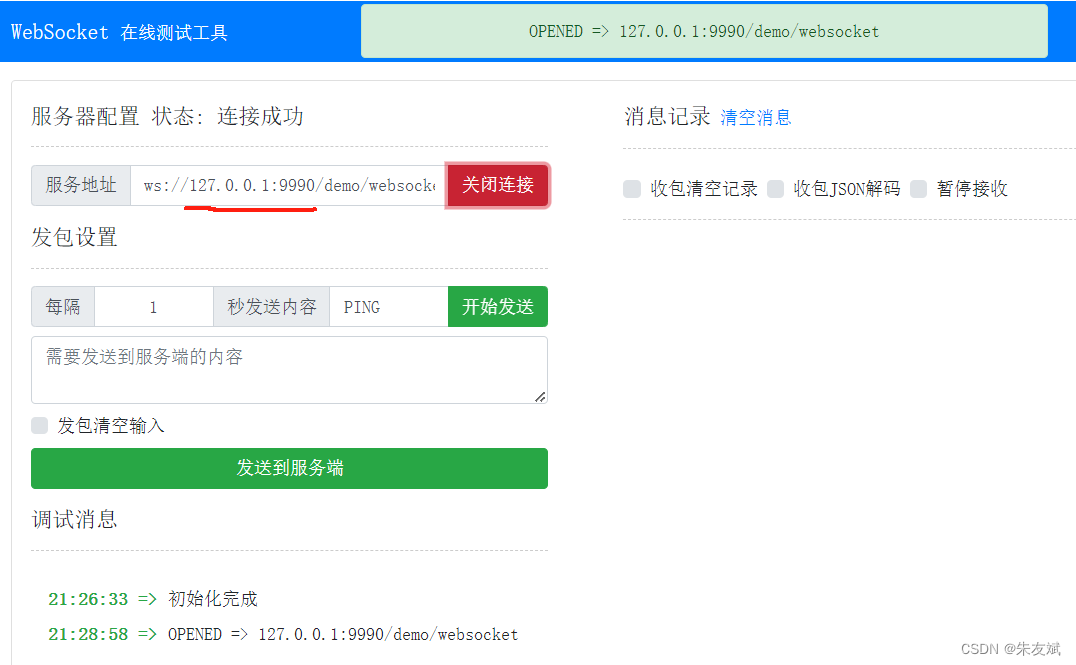
【Nginx笔记02】通过Nginx服务器转发客户端的WebSocket接口到后端服务
这篇文章,主要介绍如何通过Nginx服务器转发客户端的WebSocket接口到后端服务【知识星球】。 目录 一、Nginx配置WebSocket 1.1、Nginx配置内容 1.2、客户端请求地址 1.3、创建WebSocket测试工程 1.4、启动测试 1.5、WebSocket超时问题 1.5.1、设置超时时间 …...

关于高德地图及其APP获取地图数据的研究
刚过完春节没几天,有个客户提出要获取高德地图的数据。 我看了下,回复说:这不是很简单嘛,高德有公开的开放平台,有足够的API支持用户获取数据,开发自己基于高德数据库的应用。 客户回复说:他的要…...

【Python入门教程】Python实现鸡兔同笼
今天跟大家分享一下很久之前自己做的鸡兔同笼求解问题的小游戏,使用公式和基本的判断语句即可实现,可以用来当练手或者消磨时间用。 大家在编代码的时候最重要就是先理清逻辑思路,例如应该套几层循环、分几个模块等等。然后在编码时可以先随意…...
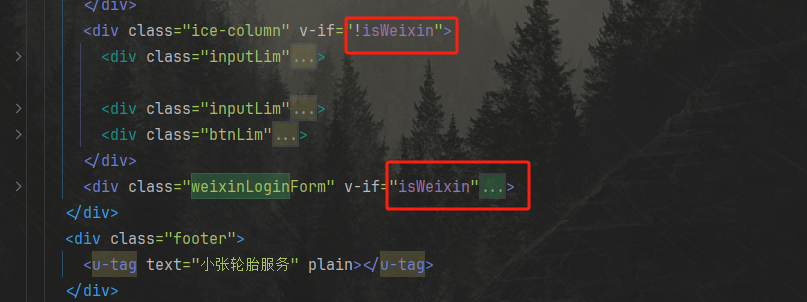
微信小程序,h5端自适应登陆方式
微信小程序端只显示登陆(获取opid),h5端显示通过账户密码登陆 例如: 通过下面的变量控制: const isWeixin ref(false); // #ifdef MP-WEIXIN isWeixin.value true; // #endif...
)
物体检测-系列教程20:YOLOV5 源码解析10 (Model类前向传播、forward_once函数、_initialize_biases函数)
😎😎😎物体检测-系列教程 总目录 有任何问题欢迎在下面留言 本篇文章的代码运行界面均在Pycharm中进行 本篇文章配套的代码资源已经上传 点我下载源码 14、Model类 14.2 前向传播 def forward(self, x, augmentFalse, profileFalse):if augm…...
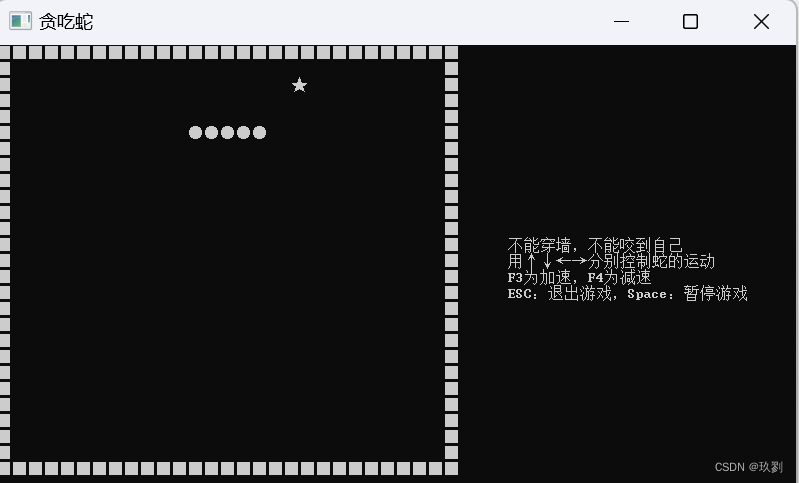
贪吃蛇(C语言)步骤讲解
一:文章大概 使用C语言在windows环境的控制台中模拟实现经典小游戏 实现基本功能: 1.贪吃蛇地图绘制 2.蛇吃食物的功能(上,下,左,右方向控制蛇的动作) 3.蛇撞墙死亡 4.计算得分 5.蛇身加…...

MySQL 数据库表设计和优化
一、数据结构设计 正确的数据结构设计对数据库的性能是非常重要的。 在设计数据表时,尽量遵循一下几点: 将数据分解为合适的表,每个表都应该有清晰定义的目的,避免将过多的数据存储在单个表中。使用适当的数据类型来存储数据&…...

JavaScript进阶-高阶技巧
文章目录 高阶技巧深浅拷贝浅拷贝深拷贝 异常处理throw抛异常try/caych捕获异常debugger 处理thisthis指向改变this 性能优化防抖节流 高阶技巧 深浅拷贝 只针对引用类型 浅拷贝 拷贝对象后,里面的属性值是简单数据类型直接拷贝值,如果属性值是引用数…...

C语言中“#“和“##“的用法
1. 前言 # :把宏参数变为一个字符串, ##:把两个宏参数贴合在一起. 2. 一般用法 #include<stdio.h> #define toString(str) #str //转字符串 #define conStr(a,b) (a##b)//连接 int main() { printf(toString(12345)): //输出字符串&q…...
)
Linux命令-clock命令(用于调整 RTC 时间)
说明 clock命令用于调整 RTC 时间。 RTC 是电脑内建的硬件时间,执行这项指令可以显示现在时刻,调整硬件时钟的时间,将系统时间设成与硬件时钟之时间一致,或是把系统时间回存到硬件时钟。 语法 clock [--adjust][--debug][--dir…...

编程笔记 Golang基础 045 math包
编程笔记 Golang基础 045 math包 一、math包主要功能常量:函数:数值运算:三角函数:对数函数:随机数相关: 二、示例代码一三、示例代码二小结 Go 语言的标准库 math 提供了一系列基础数学函数和常量…...
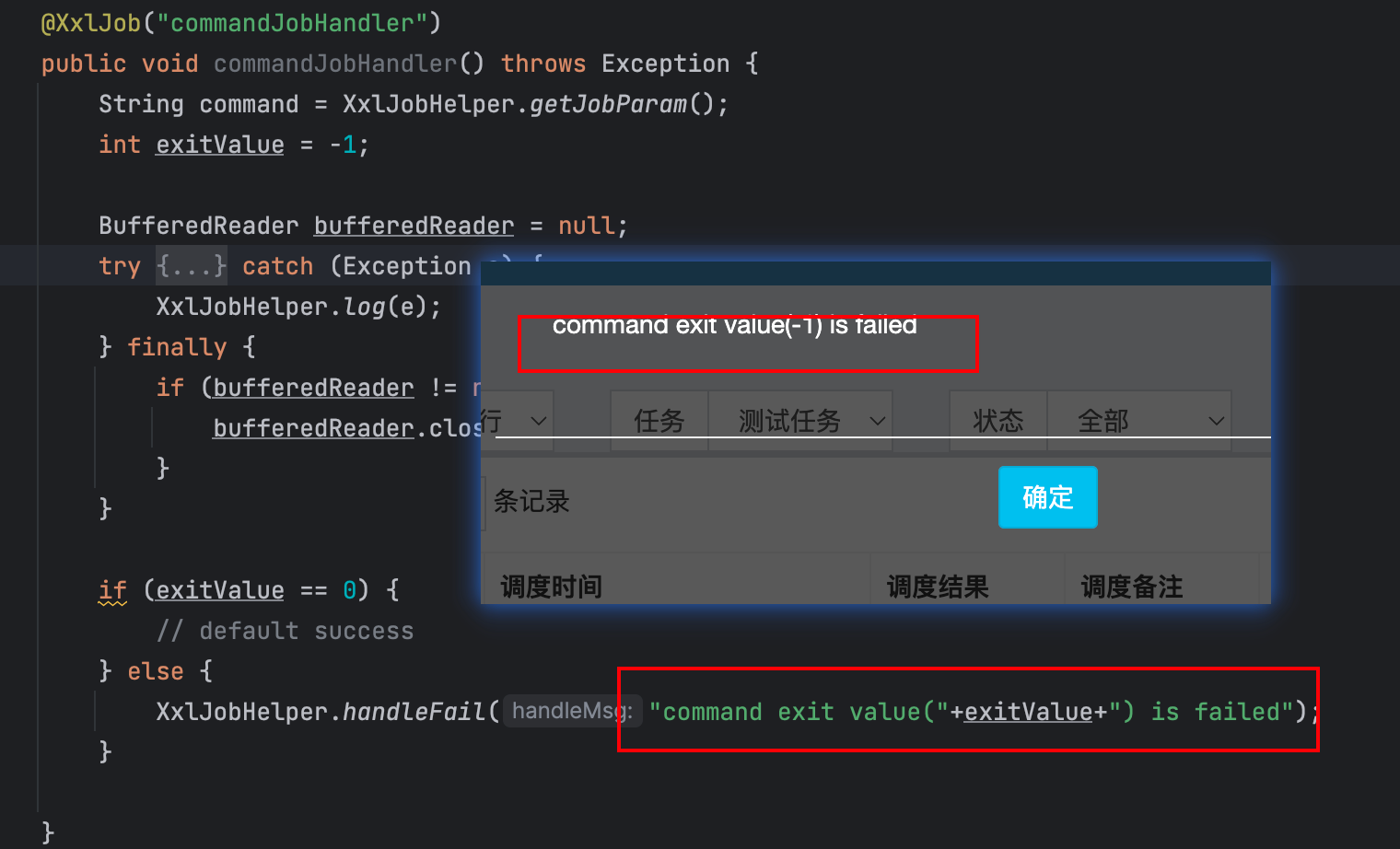
[Java 探索者之路] 一个大厂都在用的分布式任务调度平台
分布式任务调度平台是一种能够在分布式计算环境中调度和管理任务的系统,在此环境下,各个任务可以在独立的节点上运行。它有助于提升资源利用率,增强系统扩展性以及提高系统对错误的容忍度。 文章目录 1. 分布式任务调度平台1. 基本概念1.1 任…...

基于JAVA springboot+mybatis智慧生活分享平台设计和实现
基于JAVA springbootmybatis智慧生活分享平台设计和实现 博主介绍:多年java开发经验,专注Java开发、定制、远程、文档编写指导等,csdn特邀作者、专注于Java技术领域 作者主页 央顺技术团队 Java毕设项目精品实战案例《1000套》 欢迎点赞 收藏 ⭐留言 文末…...
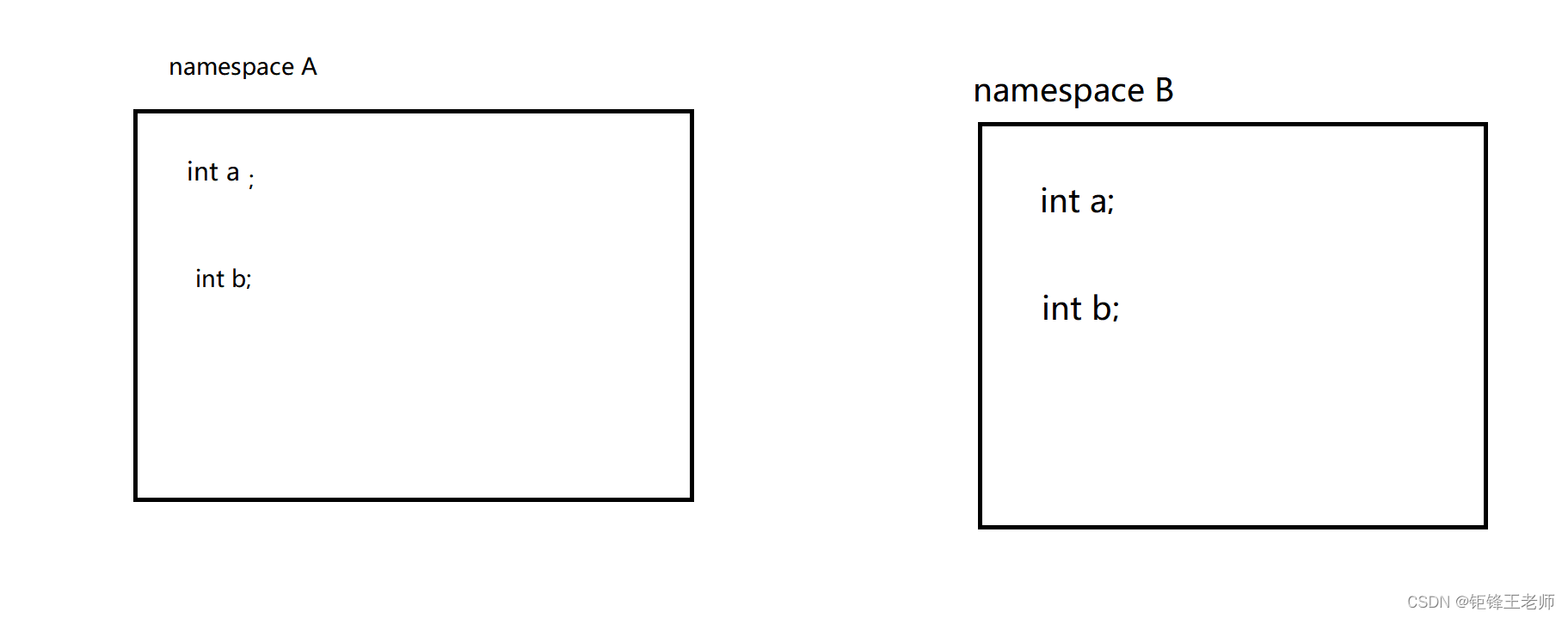
详细了解C++中的namespace命名空间
键盘敲烂,月薪过万,同学们,加油呀! 目录 键盘敲烂,月薪过万,同学们,加油呀! 一、命名空间的理解 二、::作用域运算符 三、命名空间(namespace&…...

#WEB前端(HTML属性)
1.实验:a,img 2.IDE:VSCODE 3.记录: a: href插入超链接 默认情况下在本窗口打开链接, target可以设置打开的窗口,parent在父窗口打开,blank新开串口打开,top在顶层串口打开,self为默认在本窗口打开 img: 插入图片 可以插…...

LeetCode---【和的操作】
目录 两数之和我的答案在b站up那里学到的【然后自己复写】 和为 K 的子数组在b站up那里学到的【然后自己复写】 三数之和在b站up那里学到的【然后自己复写】 两数相加【链表】我的半路答案:没有看到是链表在b站up那里学到的【复写失败后整理】 两数之和 我的答案 …...
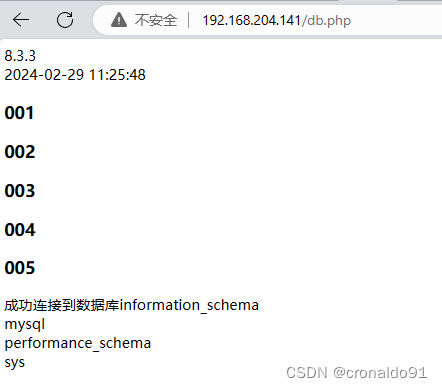
Docker容器与虚拟化技术:OpenEuler 使用 docker-compose 部署 LNMP
目录 一、实验 1.环境 2.OpenEuler 部署 docker-compose 3.docker-compose 部署 LNMP 二、问题 1.ntpdate未找到命令 2.timedatectl 如何设置时区与时间同步 3.php网页显示时区不对 一、实验 1.环境 (1)主机 表1 主机 系统架构版本IP备注Lin…...

Vue记事本应用实现教程
文章目录 1. 项目介绍2. 开发环境准备3. 设计应用界面4. 创建Vue实例和数据模型5. 实现记事本功能5.1 添加新记事项5.2 删除记事项5.3 清空所有记事 6. 添加样式7. 功能扩展:显示创建时间8. 功能扩展:记事项搜索9. 完整代码10. Vue知识点解析10.1 数据绑…...
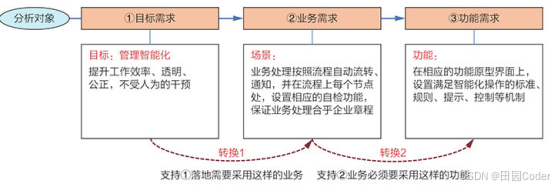
大话软工笔记—需求分析概述
需求分析,就是要对需求调研收集到的资料信息逐个地进行拆分、研究,从大量的不确定“需求”中确定出哪些需求最终要转换为确定的“功能需求”。 需求分析的作用非常重要,后续设计的依据主要来自于需求分析的成果,包括: 项目的目的…...

关于nvm与node.js
1 安装nvm 安装过程中手动修改 nvm的安装路径, 以及修改 通过nvm安装node后正在使用的node的存放目录【这句话可能难以理解,但接着往下看你就了然了】 2 修改nvm中settings.txt文件配置 nvm安装成功后,通常在该文件中会出现以下配置&…...

定时器任务——若依源码分析
分析util包下面的工具类schedule utils: ScheduleUtils 是若依中用于与 Quartz 框架交互的工具类,封装了定时任务的 创建、更新、暂停、删除等核心逻辑。 createScheduleJob createScheduleJob 用于将任务注册到 Quartz,先构建任务的 JobD…...
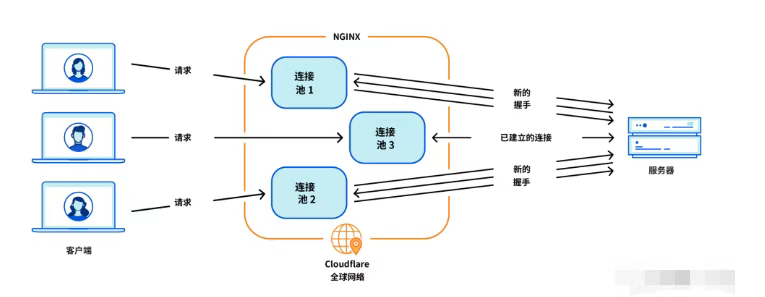
Cloudflare 从 Nginx 到 Pingora:性能、效率与安全的全面升级
在互联网的快速发展中,高性能、高效率和高安全性的网络服务成为了各大互联网基础设施提供商的核心追求。Cloudflare 作为全球领先的互联网安全和基础设施公司,近期做出了一个重大技术决策:弃用长期使用的 Nginx,转而采用其内部开发…...
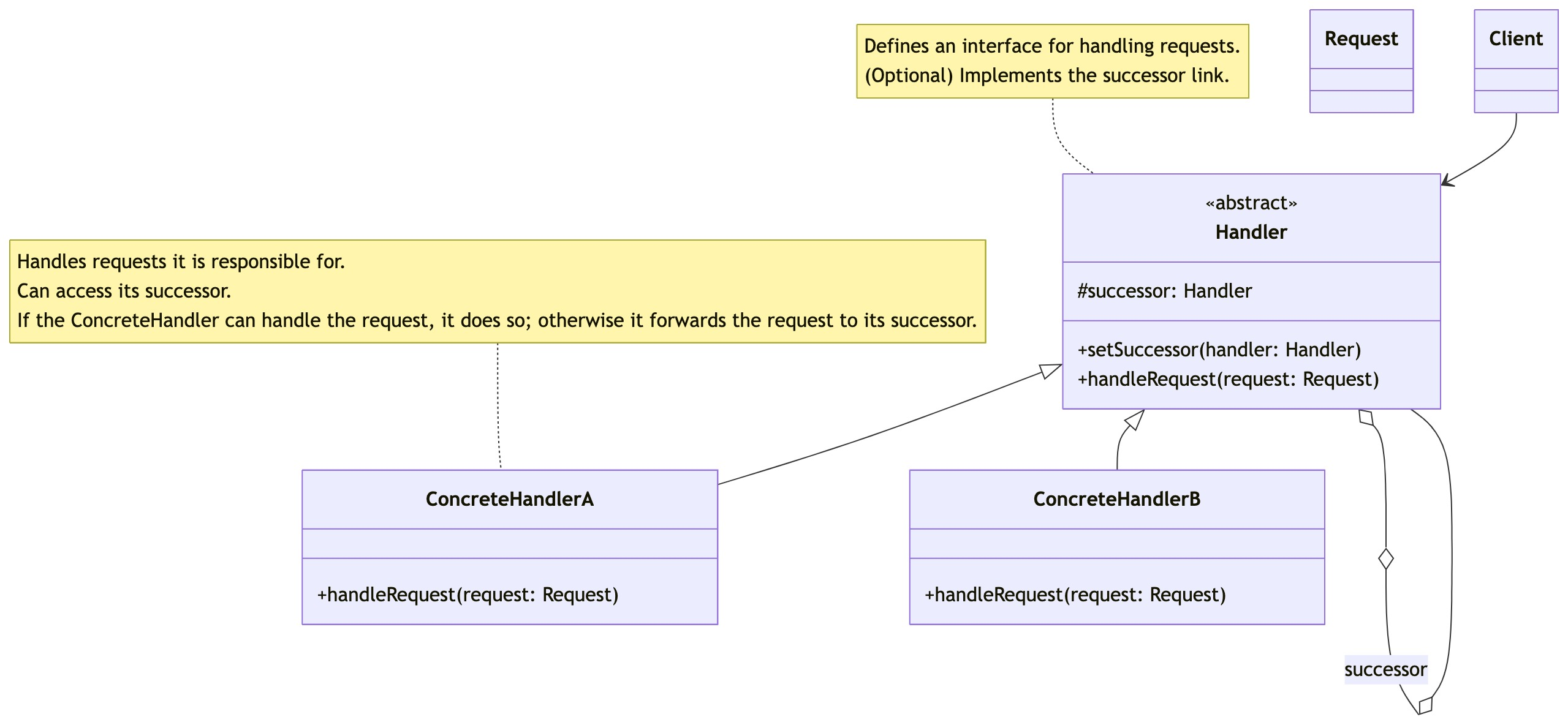
零基础设计模式——行为型模式 - 责任链模式
第四部分:行为型模式 - 责任链模式 (Chain of Responsibility Pattern) 欢迎来到行为型模式的学习!行为型模式关注对象之间的职责分配、算法封装和对象间的交互。我们将学习的第一个行为型模式是责任链模式。 核心思想:使多个对象都有机会处…...

智能分布式爬虫的数据处理流水线优化:基于深度强化学习的数据质量控制
在数字化浪潮席卷全球的今天,数据已成为企业和研究机构的核心资产。智能分布式爬虫作为高效的数据采集工具,在大规模数据获取中发挥着关键作用。然而,传统的数据处理流水线在面对复杂多变的网络环境和海量异构数据时,常出现数据质…...
)
Typeerror: cannot read properties of undefined (reading ‘XXX‘)
最近需要在离线机器上运行软件,所以得把软件用docker打包起来,大部分功能都没问题,出了一个奇怪的事情。同样的代码,在本机上用vscode可以运行起来,但是打包之后在docker里出现了问题。使用的是dialog组件,…...

[免费]微信小程序问卷调查系统(SpringBoot后端+Vue管理端)【论文+源码+SQL脚本】
大家好,我是java1234_小锋老师,看到一个不错的微信小程序问卷调查系统(SpringBoot后端Vue管理端)【论文源码SQL脚本】,分享下哈。 项目视频演示 【免费】微信小程序问卷调查系统(SpringBoot后端Vue管理端) Java毕业设计_哔哩哔哩_bilibili 项…...

数学建模-滑翔伞伞翼面积的设计,运动状态计算和优化 !
我们考虑滑翔伞的伞翼面积设计问题以及运动状态描述。滑翔伞的性能主要取决于伞翼面积、气动特性以及飞行员的重量。我们的目标是建立数学模型来描述滑翔伞的运动状态,并优化伞翼面积的设计。 一、问题分析 滑翔伞在飞行过程中受到重力、升力和阻力的作用。升力和阻力与伞翼面…...
